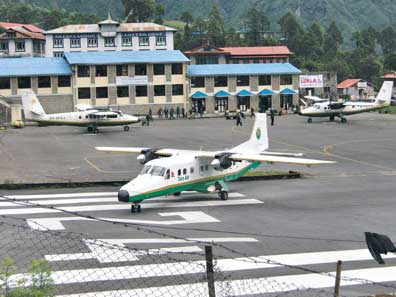

Plane shortage limiting tourist movement in Everest region- Travel agencies

Travel agencies reported that due to the shortage of aircraft , tourist movement in the Everest region is likely to be affected this season.
With scores of domestic airlines out of service for the last 18 months, the impact has been detrimental to Lukla Airport, the gateway to Mt Everest.
Lukla airport, situated at an altitude of 2,843 metres, has earned the reputation as one of the most extreme and dangerous airports in the world. Lukla can only handle special short take-off and landing (STOL) aircraft , like the Twin Otter or Dornier. Lukla Airport is one of Nepal’s busiest airports, handling more than 70-80 flights during the Oct-Nov period, is likely to see a 50 percent drop in aircraft traffic this season, airline operators and travel agencies said. Presently 30-32 flights are being conducted daily, almost half of what Lukla observed in 2011. “There is a huge shortage of aircraft in the Lukla sector, which has created extreme pressure on airlines to handle the rush,” said an airport official. “Bad weather conditions are another reason that aircraft s and airports are unable to cope with the traveller crowd at present,” the official added. Hundreds of tourists flock to trek the foothill of the planet’s highest peak during the October-November period.
The Tourism Ministry statistics show that there were 105,015 foreign trekkers last year, of which the Everest region received 36,518 of them. The number of Nepali trekking and mountaineering guides is almost double the number of foreign trekkers. “There are large numbers of foreign trekkers this season, but due to limited aircraft , it has become difficult for us to handle them,” said Dil Basnet, a trekking guide.
Air transport is the only means to reach Lukla, due to the lack of roads. Lukla is 35-minute flight from Kathmandu, while it takes 5-6 days on foot to reach the destination. Frequent crashes and financial woes forced scores of airlines out of service. Agni previously operated 12-14 flights daily, but has been grounded since November last year.
Sita Air currently operates with a single aircraft , after one of its two aircraft crashed in Kathmandu in September last year. Airline officials said that Sita, which has been based in the western region, has also started flights to the Lukla sector following the tourist demand.
Nepal Airlines is also limited to a single aircraft , and does not operate in the sector presently. Single-engine operator Makalu Air has also been conducting chartered flights with its two aircraft in the sector. On Tuesday, due to bad weather conditions, not a single flight was allowed in the sector. Tara air cancelled 21 flights in the sector on Monday. Tara Air enjoys a monopoly on the Kathmandu-Lukla route at present. It currently operates the sector with four aircraft . “Obviously we are facing pressure, as supply is limited to cope with increased demand,” said Roshan Regmi, marketing manager of Yeti Airlines, the parent company of Tara. The entire flights to Lukla were booked by the end of August, he said.
Of Tara’s six aircraft , two serve the mid-west and far-west regions respectively. “We know that there is a huge business prospect in Lukla and two aircraft could be brought here. But we are also responsible to serve the west.”
Tara to fly Tikapur
Tara Air said on Tuesday that it will be operating a scheduled flight on the Kathmandu-Nepalgunj-Tikapur sector from October 3. Issuing a press statement, the carrier said that flights to the sector will be operating on Thursday every week. Tara has already signed an agreement with the Tikapur Airport Research and Construction and Operation Committee to conduct the flight. The fare in the sector has been fixed at Rs 2,500 for Tikapur to Nepalgunj and Rs 7,500 for Tikapur to Kathmandu, the airline said.
source: the kathmandu post,2 Oct 2013








